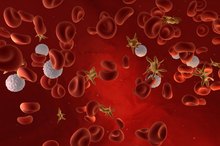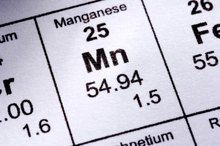Foods That May Lower WBC
White blood cells (leukocytes) are essential to the body's health. A low white blood cell (WBC) count leaves the body highly vulnerable to infection. A leukocyte count above the normal range is not necessarily indicative of an adverse medical condition, although it can be a symptom of an underlying infection such as tuberculosis or hepatitis, or of an allergic condition. It is important to understand that a high white blood cell count is associated with these conditions, but is not the cause of them. Perhaps because of this, the effect of diet on lowering white blood cell count has not been extensively researched.
White Blood Cells
White blood cells (leukocytes) form an important part of the body’s immune system 1. Like red blood cells, they develop from bone marrow in the body’s large bones, and are found throughout the bloodstream as well as in the lymphatic system. The normal white blood cell count in a liter of human blood is 4.3-10.8 × 103/mm3.
High and Low Counts
Diet Low in Methionine
Learn More
A WBC count that is higher or lower than the normal range can be a cause for concern. A high count is referred to as leukocytosis. A low count, or leukopenia, can be dangerous as it shows the body’s immune system to compromised, increasing danger of infection. It is associated with a wide range of illnesses, from leukemia to influenza and Hodgkin’s lymphoma.
- A WBC count that is higher or lower than the normal range can be a cause for concern.
- A low count, or leukopenia, can be dangerous as it shows the body’s immune system to compromised, increasing danger of infection.
The Effect of Diet
Diet and nutrition can affect white blood cell count. Individuals with a low count are advised to eat foods that help boost the immune system. Caution should also be taken about foods that carry a risk of infection, such as raw milk and cheese.
Reducing White Blood Cells
Nectarines and the Glycemic Index
Learn More
Although little research has been done on ways to reduce leukocytes through diet, a condition known as digestive leukocytosis offers pointers. This condition was first reported in 1930 by Dr, Paul Koukachoff, who found an increase in white blood cell count immediately following consumption of cooked food. The increase was not seen in subjects who ate raw food (or food heated only below a certain temperature) or in subjects who added raw food to their cooked food diet. It should be noted that Koukachoff’s methods and results have been questioned.
- Although little research has been done on ways to reduce leukocytes through diet, a condition known as digestive leukocytosis offers pointers.
- This condition was first reported in 1930 by Dr, Paul Koukachoff, who found an increase in white blood cell count immediately following consumption of cooked food.
Raw Diets
At face value, then, either a raw or uncooked food diet, or a diet incorporating a significant proportion of such food, might reduce white blood cell count or help maintain it within the normal range. Advocates of raw food diets generally advise that food should not be heated above 104 degrees Fahrenheit. The claimed benefit is that this preserves dietary enzymes that are destroyed at higher temperatures. Little research, however, has been conducted on the connection between raw food and leukocyte count, and the benefits of raw diets continue to be debated.
- At face value, then, either a raw or uncooked food diet, or a diet incorporating a significant proportion of such food, might reduce white blood cell count or help maintain it within the normal range.
- Little research, however, has been conducted on the connection between raw food and leukocyte count, and the benefits of raw diets continue to be debated.
Related Articles
References
- "Human Physiology: From Cells to Systems"; Lauralee Sherwood; 2009
- Vermeire S, Van assche G, Rutgeerts P. Laboratory markers in IBD: useful, magic, or unnecessary toys? Gut. 2006;55(3):426-31. doi:10.1136/gut.2005.069476
- Kabat GC, Kim MY, Manson JE, et al. White Blood Cell Count and Total and Cause-Specific Mortality in the Women's Health Initiative. Am J Epidemiol. 2017;186(1):63-72. doi:10.1093/aje/kww226
- Riley LK, Rupert J. Evaluation of Patients with Leukocytosis. Am Fam Physician. 2015;92(11):1004-11.
- Newburger PE, Dale DC. Evaluation and management of patients with isolated neutropenia. Semin Hematol. 2013;50(3):198-206. doi:10.1053/j.seminhematol.2013.06.010
- Vermeire S, Van Assche G, Rutgeerts P. Laboratory markers in IBD: useful, magic, or unnecessary toys? Gut. 2006;55:426-31.
- Wilkins T, Jarvis K, Patel J. Diagnosis and management of Crohn's disease." Am Fam Physician. 2011;84:1365-75.
Writer Bio
Kim Davis began writing in 1977. His articles have appeared in "The New Musical Express," "The Literary Review" and "City Limits," as well as numerous Web sites. Davis is the consulting editor for the "New York Times"/New York University collaboration, "Local: East Village." He has a Doctor of Philosophy in philosophy from Bristol University.









